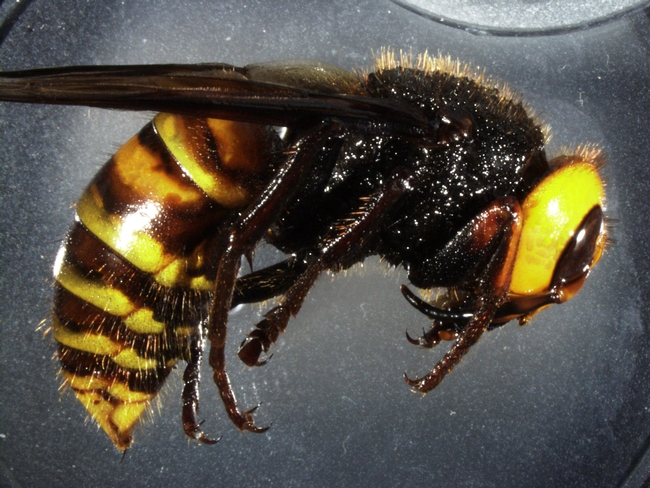- Author: Kathy Keatley Garvey
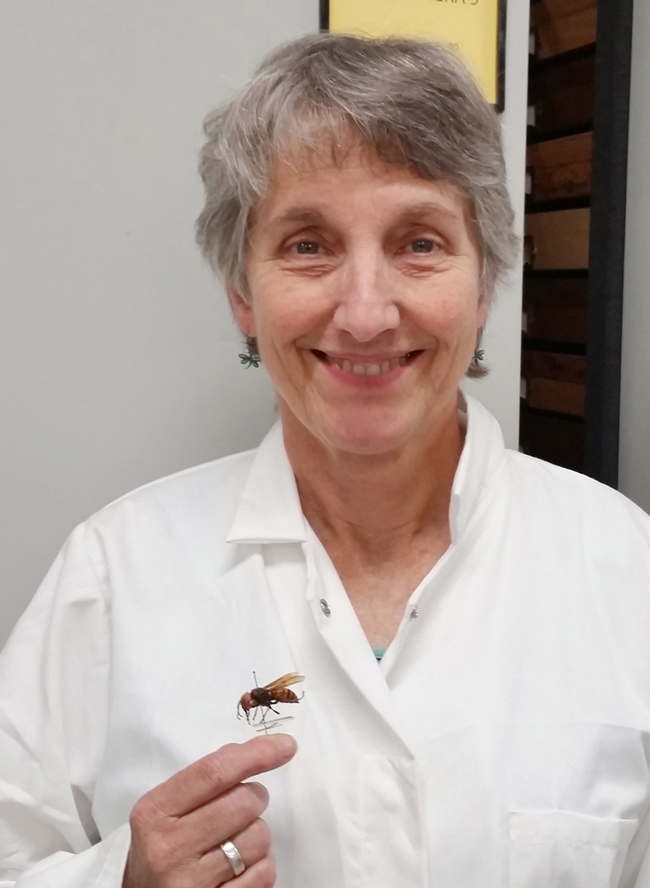
No, they're not back, but they are in the news.
Or specifically, in a podcast.
Noted hymenopterist Lynn Kimsey, director of the Bohart Museum of Entomology and professor of entomology, UC Davis Department of Entomology and Nematology, shed light on the giant insect in an interview with urban entomologist Michael Bentley on his BugBytes podcast. Click here to listen.
Bentley serves as the director of training and education for the National Pest Management Association (NPMA), headquartered in Fairfax, Va., and hosts NPMA's BugBytes. Kimsey, a global authority on wasps, bees and other insects, is a two-term past president of the International Society of Hymenopterists.
They talked about the history of the hornet, its biology, its range, its behavior, its stings, and the news media frenzy.
Basically, two incidents occurred in North America last year. A single colony of the Asian giant hornet (AGH), Vespa mandarinia, was found and destroyed Sept. 18, 2019 in Nanaimo, Vancouver Island, Canada, and a single dead hornet was found Dec. 8, 2019 in nearby Blaine, Wash. “There is no evidence that there are any more hornets in the vicinity of Vancouver or anywhere else on the West Coast," Kimsey told us in a BugSquad piece published on May 5.
Concerned beekeepers, however, worried that the hornets could become established and decimate their hives. Subsequently, entomologists from the Department of Agriculture and Washington State University urged folks to be on the alert and report any sightings.
Suddenly, citizens throughout the country reported seeing scores of "murder hornets," which turned out to be yellow jackets, European paper wasps, hover flies, hoverflies, moths and even a Jerusalem cricket (potato bug). Entomologists fielded all kinds of questions--and still are. Stephane De Greef, a Belgium-born entomology advocate, traveler, field guide, and photographer, called the frenzy "a bloody dumpster fire." He launched a fun (and informative) Facebook page, Is This a Murder Hornet?"
In the podcast, Kimsey relates that the Asian giant hornets are native to Asia, where the residents tolerate them. The beekeeping industry in Washington state, however, was "convinced that they are killing our honey bees," Kimsey told Bentley. "There's no basis in reality as far as I can tell," she said.
The Asian giant hornet is "one of about a dozen or so species in this genus," Kimsey said. She described them as "comically large and menacing looking."
The specimens in the Bohart Museum of Entomology are about 1.5 inches long. "I've never seen one two inches long. But it's a big animal--no question about it."
Bentley also discussed entomologist Justin Schmidt's Sting Pain Index, which rates the painful stings of some 83 hymenopteran species.
Kimsey agreed that the Asian giant hornet "can deliver a lot of venom" and "can sting repeatedly." But in her opinion, "the honey bee sting is the worst."
Other points Kimsey brought out included:
- The Asian giant hornets probably arrived here in cargo ships
- The larvae and pupae are restaurant-fare in some parts of Asia and are quite the delicacy
- The coronavirus pandemic has resulted in fewer cargo ships arriving in the United States from Asia, and thus fewer opportunities for hitchhikers.
Be sure to listen to the educational and entertaining podcast for the details. Or as NPMA wrote: "Where did the Asian giant hornet come from, has it become established in North America, and what threat could it pose to the U.S.? Get answers to these and many more questions in this episode featuring famed hymenopterist, Dr. Lynn Kimsey, as she dispels myths and rumors about this interesting insect."
Related Bug Squad blogs:
- About Those Asian Hornets (May 4, 2020)
- The Hornet Wars: 'A Bloody Dumpster Fire" (May 5, 2020)
- How Do You Say Murder Hornets? Delicious (May 8, 2020)
Matan Shelomi, former graduate student of Lynn Kimsey's and now an assistant professor of entomology at the National Taiwan University in Taipei, Taiwan, enjoys them. - Incredible Work, and Timely, on 22 Species of Hornets (May 12, 2020)

- Author: Kathy Keatley Garvey
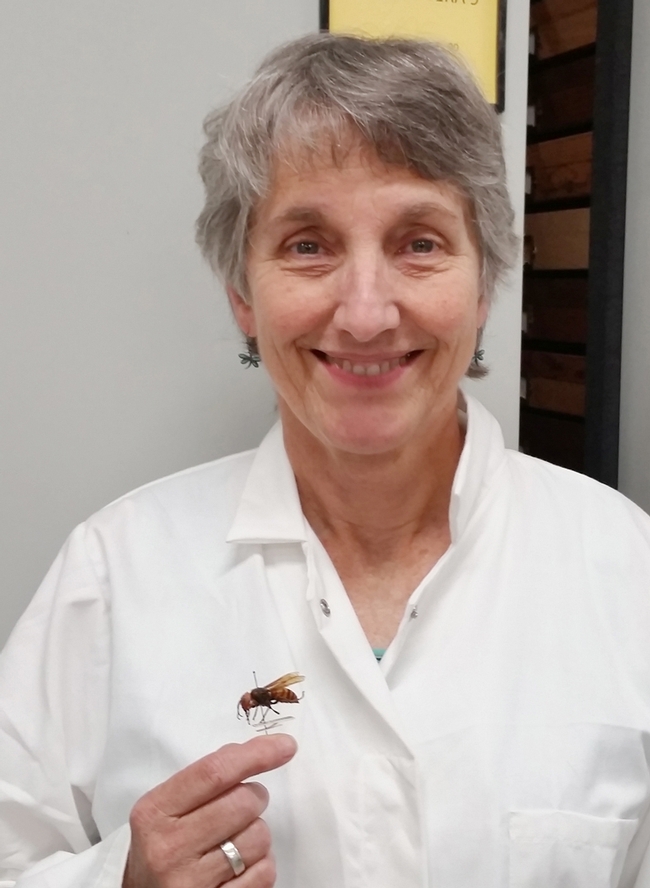
Lynn Kimsey, director of the Bohart Museum of Entomology and UC Davis professor of entomology, will answer questions from 11 a.m. to 11:45 a.m., on Friday, May 22 at the Bohart's first-ever virtual open house on FacebookLive. To watch or participate, access the Bohart Museum Facebook site. It will be recorded for those unable to watch it at that time.
Kimsey, an authority on wasps and bees, is a two-time past president of the International Society of Hymenopterists. The director of the Bohart Museum and executive director of the Bohart Museum Society since 1990, she has also served as interim chair and vice chair of the UC Davis Department of Entomology, now the UC Davis Department of Entomology and Nematology.
She recently won the C. W. Woodworth Award, the highest honor given by the Pacific Branch, Entomological Society of America. (See news story.)
“We thought people would be interested in talking to a wasp/bee expert given all the news about wasps and with spring coming and more people tuning into nature and their back yards due to sheltering in place,” said Tabatha Yang, education and outreach coordinator. “We anticipate ‘murder hornet' questions.
“We host open houses to connect people directly to scientists,” Yang said. “Since the museum is closed at this time and social distancing is required, we are setting this up so people can connect with Lynn. We hope to do this regularly with other scientists, but this will be our first.”
North America's first known colony of the Asian giant hornet, Vespa mandarinia, was detected (and destroyed) in September 2019 on Vancouver Island, British Columbia. A single V. mandarinia was found dead in Blaine, Wash., in December 2019.
Three entomologists, including Kimsey just published research on this and the 21 other known species of hornets in the genus Vespa, in the journal Insect Systematics and Diversity.
The article, “The Diversity of Hornets in the Genus Vespa (Hymenoptera: Vespidae; Vespinae); Their Importance and Interceptions in the United States,” is the work of lead author Allan Smith-Pardo, U.S. Department of Agriculture Animal and Plant Health Inspection Service (APHIS); and co-authors James Carpenter of the American Museum of Natural History's Division of Invertebrate Zoology, and Lynn Kimsey.
The Bohart Museum is also celebrating the birthday anniversary (May 23) of Carl Linnaeus, the father of taxonomy. Linnaeus (1707-1778), was a Swedish botanist zoologist and physician who formalized the modern system of naming organisms. “It's a good time to celebrate biodiversity, scientific discovery, and museum collections,” Yang said.
In addition, talented Bohart student associates have crafted downloadable coloring pages for the family craft activity.
The Bohart also has pre-recorded tours linked to its website http://bohart.ucdavis.edu/
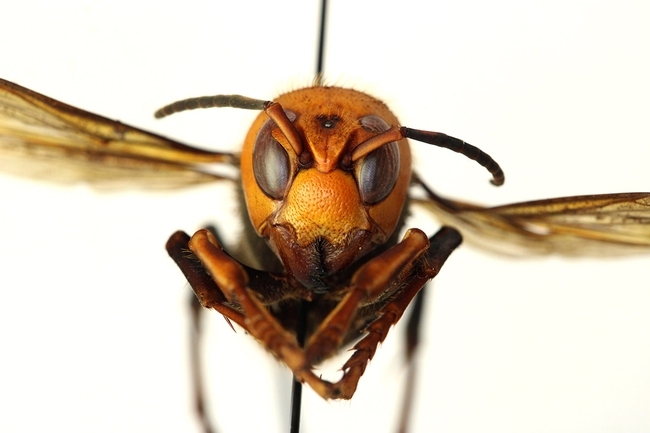
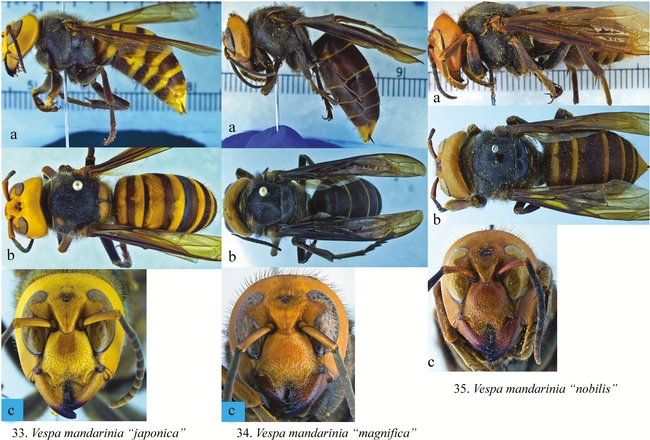
- Author: Kathy Keatley Garvey
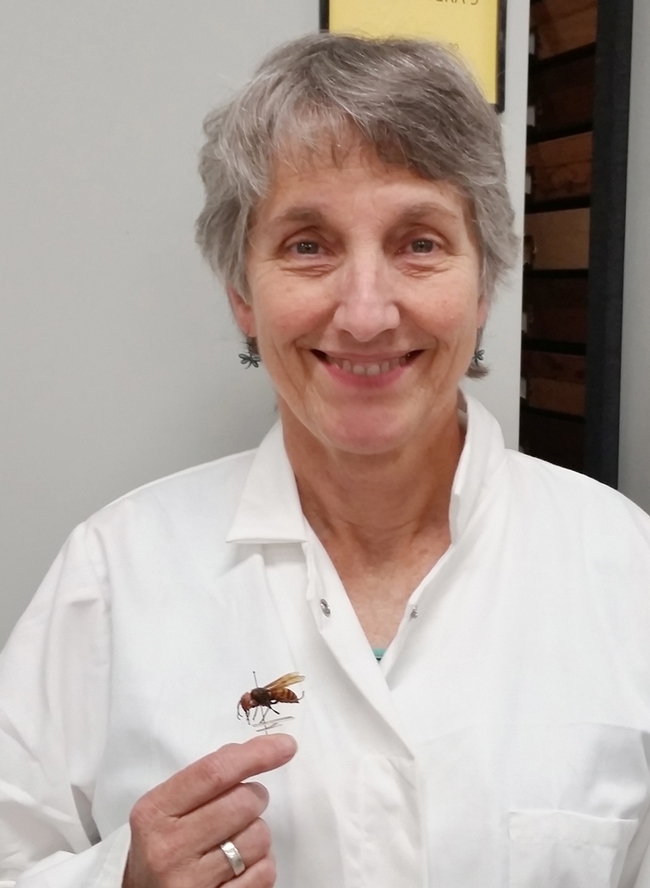
And timely, too!
While many folks are panicking about the first detected (and destroyed) colony of Asian giant hornets, aka “murder hornets,” in North America, three entomologists have just published research on this and the 21 other known species of hornets in the genus Vespa, in the journal Insect Systematics and Diversity.
The article, “The Diversity of Hornets in the Genus Vespa (Hymenoptera: Vespidae; Vespinae); Their Importance and Interceptions in the United States,” is the work of three entomologists: lead author Allan Smith-Pardo, U.S. Department of Agriculture Animal and Plant Health Inspection Service (APHIS); and co-authors James Carpenter of the American Museum of Natural History's Division of Invertebrate Zoology, and Lynn Kimsey, director of the Bohart Museum of Entomology and professor of entomology at UC Davis.
North America's first known colony of the Asian giant hornet, Vespa mandarinia, was detected (and, yes, destroyed) in September 2019 on Vancouver Island, British Columbia. A single V. mandarinia was found dead in Blaine, Wash., in December 2019.
“Hornet species identification can be sometimes difficult because of the amount of intraspecific color and size variation,” the authors wrote in their abstract. “This has resulted in many species-level synonyms, scattered literature, and taxonomic keys only useful for local populations. We present a key to the world species, information on each species, as well as those intercepted at United States ports of entry during the last decade.”

Vespa species are “primarily predators of other insects, and some species are known to attack and feed on honey bees (Apis mellifera), which makes them a serious threat to apiculture,” the authors wrote in their abstract.
In the USDA-funded research, the trio combed through scientific literature and museum collections to separate the species. They list their sources and offer insights on the distribution of each hornet, and a discussion.
The Asian giant hornet's distribution is India, Sri Lanka, Bhutan, Nepal, Myanmar, Thailand, Laos, Vietnam, Malaysia, Malaya, China, Hong Kong, Taiwan, eastern Russia, Korea, Japan (including Ryukyus), the authors wrote.

The Bohart Museum of Entomology, home of a global collection of nearly eight million insect specimens, houses 20 specimens of V. mandarinia. The largest one, a queen, measures about an inch and a half long, Kimsey said.
“Insects introduced in the United States often come in cargo boxes from Asia to U.S. ports, establish colonies, and expand their range,” she said.
The only known European hornet to colonize the United States is Vespa crabro, introduced on the East Coast in the 1800s. “It is now fully established in the southeastern U.S,” Kimsey said. “A decade or more ago, there was a colony of another species, Vespa asiatica, reported near the Port of Long Beach but nothing ever came of that.”
What's next for the research team? "We will be continuing to create online identification tools and a detailed website," Kimsey said.
Research Conclusion:
"From 2010 to 2018, there have been close to 50 interceptions of Vespa (hornets) and Vespula (yellow jackets (Vespula) at U.S. ports of entry. Little less than half of those interceptions were hornets. The Vespa species intercepted include V. bellicosa, V. crabro, V. orientalis, V. mandarinia, and V. tropica. One of the interceptions of significance was an entire nest of V. mandarinia containing live brood and pupae that was sent via express courier from Asia. All species of Vespa, except V. crabro, which is already introduced into the eastern United States, are considered of quarantine importance by the USDA-APHIS."
A website, Invasive Hornets, part of a cooperation between the USDA, Animal Plant Health Inspection Service (APHIS), Plant Protection and Quarantine (PPQ) and the University of Georgia, is taking shape. According to the journal article: "This website contains more than 1,000 stacked, high-quality images of all the species and most of the races of the genus Vespa. It is important to have the resources for the identification and prevention of introduction of non-native species and to understand the potential effects of invasive hornets in our ecosystems. Hornets are dangerous for the beekeeping industry because they can alter pollination in agriculture and disrupt the beekeeping industry, as well as create public health and safety problem."
The authors credited senior museum scientists Christine Lebeau of the American Museum of Natural History and Steve Heydon of the Bohart Museum of Entomology “for helping to process the loan of Vespa material.” Mary Burns of the National Identification Services (NIS) of the USDA-APHIS- Plant Protection and Quarantine (PPQ) provided information about the number of interceptions of Vespa at U.S. ports of entry.
In an article posted in Entomology Today, science writer-educator Leslie Mertz wrote that the team is "building a publicly available, online adjunct to the newly published key that uses menus of distinguishing characteristics, as well as illustrations and photographs. They hope to have the online key up and running in 2021.”
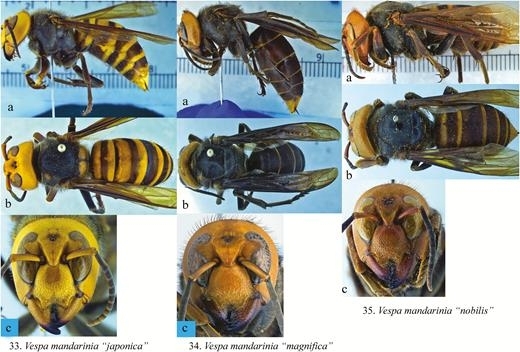
- Author: Kathy Keatley Garvey
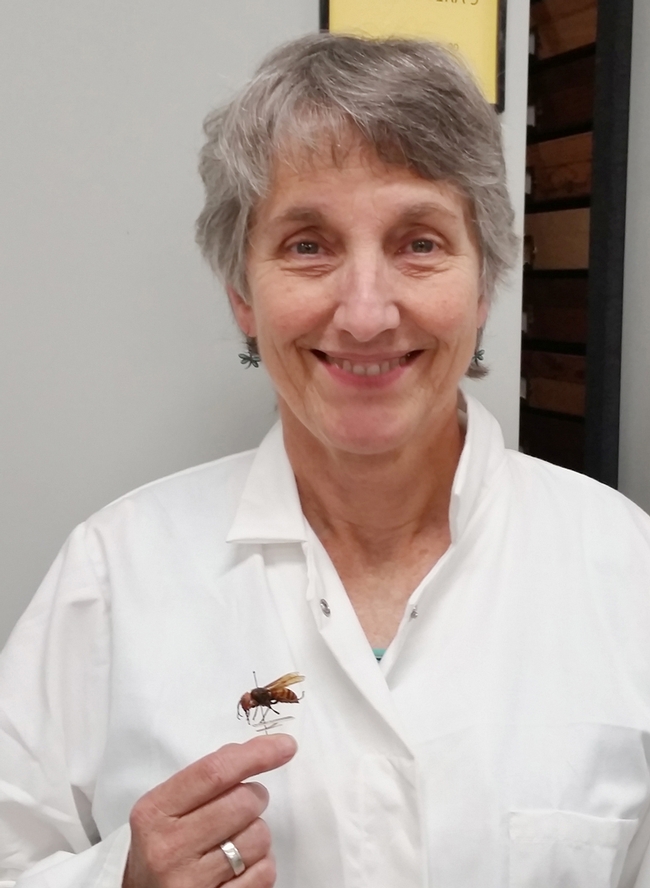
And well they should.
UC Davis wasp expert and researcher Lynn Kimsey, director of the Bohart Museum of Entomology and professor of entomology, UC Davis Department of Entomology and Nematology, called the name "ridiculous" and said "it's no more likely to sting and kill a human than a honey bee." (See Bug Squad blog)
Kimsey, a two-term past president of the International Society of Hymenopterists, told us yesterday that “Actually it's less likely, as honey bee venom packs quite a punch and it is exclusively designed to defend against vertebrates."
“The colony everyone is hyperventilating over was actually found on Vancouver Island, British Columbia, last September when it was destroyed and then a single, dead hornet was found in December in Blaine, Wash.,” Kimsey said. “There is no evidence that there are any more hornets in the vicinity of Vancouver or anywhere else on the West Coast.”
A colony of the Asian giant hornet (AGH), Vespa mandarinia, was found and destroyed Sept. 18, 2019 in Nanaimo, Vancouver Island, and the single dead hornet was found Dec. 8, 2019 in Blaine.
These were the first detections of this species in North America, and no, the so-called "murder hornets" are not out to get us. They're not out to kill you. They're not taking over the world. (Expect some upcoming horror movies, though!)
Twenty Asian giant hornet (AGH) specimens are housed in the Bohart Museum of Entomology, home of a global collection of nearly 8 million species. The largest AGH, a queen, measures about an inch and a half long, Kimsey said. She's never seen any larger than that.
Meanwhile, entomologists are bemoaning the name, "murder hornet" and the sensationalism and fear-mongering ensuing. Apparently the name originated with a Japanese researcher; out of the translation came "murder hornet."
“It's a bloody dumpster fire,” said entomology advocate, traveler and photographer Stephane De Greef, administrator of a newly created Facebook page, “Is This a Murder Hornet?”
“Some poorly-worded media reports about Asian giant hornets have triggered a veritable avalanche of nonsense online, but I can help set the record straight, wrote senior museum scientist and hymenopterist Douglas Yanega of UC Riverside Entomology Research Museum.
“One colony was found and exterminated in Nanaimo on Vancouver Island in September of 2019, with a few sightings associated,” Yanega wrote. “One wasp believed to be from that colony was found--dead--on the U.S. side of the border near Nanaimo in December. Right now, all the authorities are doing is asking people to keep their eyes peeled JUST IN CASE there were queens that escaped the destruction of the Nanaimo nest, and established their own nests nearby. I was one of the authorities brought in to consult on this case, and to my knowledge there have not been any sightings in 2020 that would suggest the eradication attempt was unsuccessful. Put bluntly, as far as we know, there are no Asian giant hornets alive in either the U.S. or Canada as of 2020, and if there are, then they would be in the immediate vicinity of Vancouver Island (about a 50 mile radius or so).”
Want to know more about them? Read the fact sheet published by Washington State University Extension. It's the work of the husband-wife team of Susan Cobey, bee breeder-geneticist and Timothy Lawrence, county director of Island County Extension (both formerly of UC Davis), and also Mike Jensen, county director of Pend Oreille. (See https://bit.ly/2SA3TxS)
“It is critical that we identify, trap, and attempt to eliminate this new pest before it becomes established and widespread,” they wrote. “Attempts to contain the spread and eradication of this invasive insect will be most effective in trapping queens during early spring before their nests become established. Finding the nests can be a bit of a challenge. Their nests are typically in the ground though they can also be found under overhangs and within wall voids. The AGH is a strong flier and often will fly up and away and have an extensive flight range. Thus tracking can be difficult.”
They advise residents to “proceed with extreme caution and contact WSDA immediately. Do not try to exterminate the nest yourself.”
The sensationalism on the media is a concern, said Lawrence, "but...we need to find out just how extensive this infestation is."
Facebook users are posting images of so-called Asian giant hornets that are actually such species as cicada killers, European hornets, southern yellow jacket queens, sawflies, hoverflies, a beetle, and even a moth.
“Yes, it is possible this species could establish,” wrote Sloan Tomlinson, a parasitoid wasp specialist and educator. “Has it yet? No. Until concrete evidence is presented about any further establishment by this species, it's simply conjecture. Additionally, even IF this species is established, their infamy is overhyped and sensationalized. In Japan they do indeed kill around 30 people a year. Around 40 people are killed annually in the US by domestic dogs.”
Doctoral candidate and researcher Ellie Field of Iowa State University wrote on Facebook that “the murder hornet articles are making the rounds quickly and they seem to be doing more harm than good. Yes, it is awesome to track insect populations (particularly staying watchful for non-native and potentially invasive species). But no, the Asian giant hornet (Vespa mandarinia) is not going to destroy America. The one nest and individual that was found around Vancouver last year was destroyed, and this doesn't indicate any establishment. Introduction events happen all the time, all across the world! That region should continue to keep a watchful eye, but for everyone else this is not going to be relevant. There is no invasion, just a small possibility that some may have overwintered in that area.”
Those unsure about insect identification can email an image to Lynn Kimsey at lskimsey@ucdavis.edu or contact the Entomological Society of America at https://www.entsoc.org/ or https://bit.ly/2W2jRmi.
Entomologists also identify insects on such Facebook pages as “Insect Identification,” “Entomology,” and “Spider and Insect Enthusiast.”
Meanwhile, they're trying to douse the "bloody dumpster fires."
(Update: UC Davis distinguished professor Walter Leal, who studied and worked in Japan, asked a Japanese friend today about the origin of "murder hornet": The Asian giant hornet, Vespa mandarinia, is called “Kiiro Suzume Bachi (キイロスズメバチ)” in Japanese. It injects its venoms, sometimes inducing severe anaphylaxis. The article in BBC introduced Asian giant hornet, Vespa mandarinia as “murder hornet” is at https://www.bbc.com/news/52533
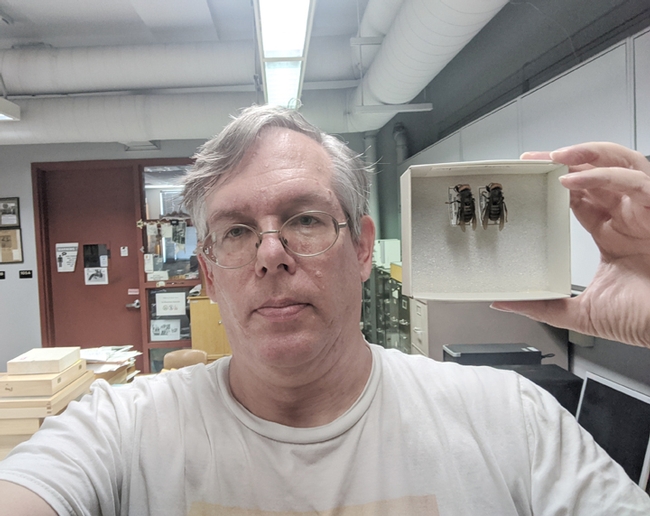
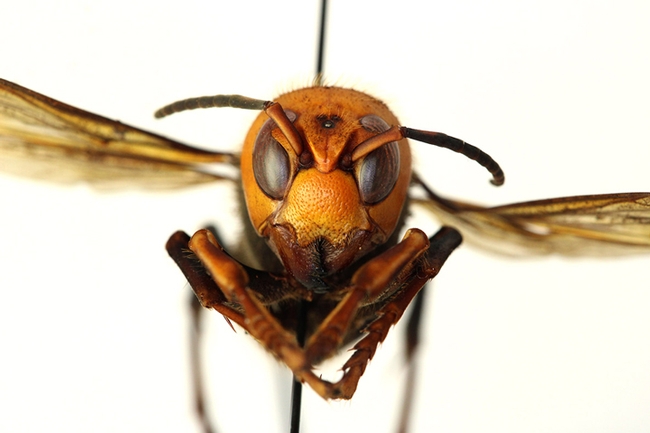
- Author: Kathy Keatley Garvey

First there were the Africanized honey bees, which sensationalists called "the killer bees."
Don't even mention "assassin flies" or "bullet ants" or "deathwatch beetles."
Now there are the Asian giant hornets (AGH), Vespa mandarinia, which sensationalists have dubbed "murder hornets."
"It's ridiculous to call them murder hornets,” says noted UC Davis wasp expert and researcher Lynn Kimsey, director of the Bohart Museum of Entomology and professor of entomology, UC Davis Department of Entomology and Nematology.
“It's no more likely to sting and kill a human than a honey bee,” said Kimsey, a two-term past president of the International Society of Hymenopterists, an organization that studies bees, wasps, ants, and sawflies.
“Actually it's less likely, as honey bee venom packs quite a punch and it is exclusively designed to defend against vertebrates,” she said.
“The colony everyone is hyperventilating over was actually found on Vancouver Island, British Columbia, last September when it was destroyed and then a single, dead hornet was found in December in Blaine, Wash.,” Kimsey said. “There is no evidence that there are any more hornets in the vicinity of Vancouver or anywhere else on the West Coast.”
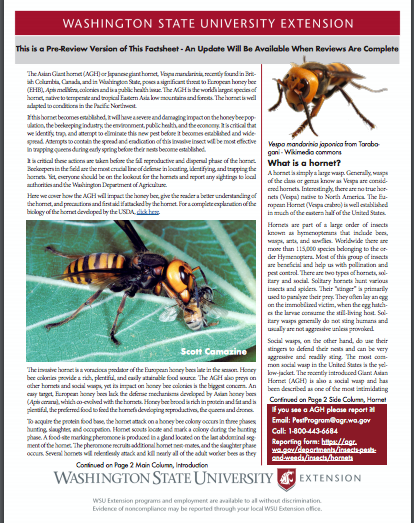
These were the first detections of this species in North America, but there may be more, according to the Washington State Department of Agriculture (WSDA). Beekeepers have reported “observations” (which may or may not be the same species) dating back to October 2019, according to officials in Washington State University's Department of Entomology and Cooperative Extension. They and the beekeeping organizations want to know what's out there and they want folks to keep a lookout for them.
Said Kimsey: “A decade or more ago there was a colony of another species, Vespa asiatica, reported near the Port of Long Beach but nothing ever came of that either. A European species, Vespa crabro, was introduced into the East Coast perhaps a century ago and it is now fully established in the southeastern U.S.”
Kimsey points out that insects often come in cargo boxes from Asia to U.S. ports, establish colonies, and expand their range.
A soon-to-be-published article in the Entomological Society of America's journal, Insect Systematics and Diversity, promises to shed more light on the genus and the history of introductions in the United States.Kimsey and colleagues Allanmith-Pardo of the USDA and James Carpenter of the America Museum of History, New York, co-authored the review article.
In the abstract, the authors define Vespa as social wasps that are “primarily predators of other insects, and some species are know to attack and feed on honey bees, Apis mellifera, which makes them a serious threat to apiculture.”
“Vespa nests can be physically large, with over 1,000 workers, but usually with hundreds of workers,” they wrote. “Nests can be aerial, attached to tree branches or in shrubs, in crevices, under eaves or underground depending on the species. Depending on the latitude, nests can be either annual, started by a new queen every spring, or perennial, where young queens take over from old ones. Colonies in warm tropical climates tend to be perennial.”
Washington State University (WSU) Extension recently published an AGH fact sheet, the work of three scientists: Susan Cobey, bee breeder-geneticist and husband Timothy Lawrence, county director of Island County Extension (both formerly of UC Davis), and Mike Jensen, county director of Pend Oreille. (See https://bit.ly/2SA3TxS)
Yes, hornets are huge. They measure about two inches long, and the queens can fly up to 20 miles per day, said Cobey, who examined specimens in Japan last December and shipped some of them to WSU.
The WSU scientists wrote that AGH “is the world's largest species of hornet, native to temperate and tropical Eastern Asia low mountains and forests. The hornet is well adapted to conditions in the Pacific Northwest.”
“The primary purpose of venom is defense against predators by inflicting pain and damage,” they wrote. ”Vespa mandarinia is one of the two most venomous known insects in the world.. The amount of venom each wasp delivers (4.1 μl/ wasp) has designated V. mandarinia as the most venomous insect. In comparison, the honey bee has about 0.6μl/bee. When foraging for food in spring, the AGH is not highly defensive – unless its nest is disturbed. Late summer and fall, with the high demand for protein, they become very aggressive when attacking or occupying a honey bee colony.”
“It is critical that we identify, trap, and attempt to eliminate this new pest before it becomes established and widespread,” they wrote. “Attempts to contain the spread and eradication of this invasive insect will be most effective in trapping queens during early spring before their nests become established. Finding the nests can be a bit of a challenge. Their nests are typically in the ground though they can also be found under overhangs and within wall voids. The AGH is a strong flier and often will fly up and away and have an extensive flight range. Thus tracking can be difficult.”
They advise residents to “proceed with extreme caution and contact WSDA immediately. Do not try to exterminate the nest yourself.”
Entomologists call them Asian giant hornets or Vespa mandarinia.
Social media?
Murder hornets.
Could we just go back to calling them Asian giant hornets or AGH or Vespa mandarina?
Please?
